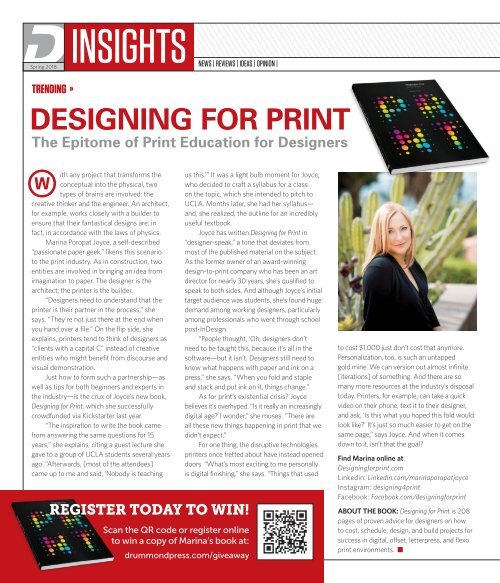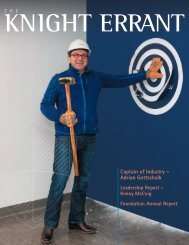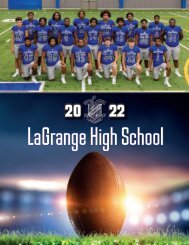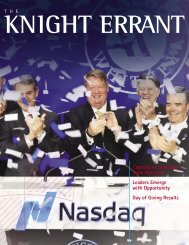The Beat - Spring 2018
Drummond's Spring 2018 Edition of The Beat.
Drummond's Spring 2018 Edition of The Beat.
Create successful ePaper yourself
Turn your PDF publications into a flip-book with our unique Google optimized e-Paper software.
<strong>Spring</strong> <strong>2018</strong><br />
INSIGHTS<br />
NEWS<br />
| REVIEWS | IDEAS | OPINION |<br />
TRENDING »<br />
DESIGNING FOR PRINT<br />
<strong>The</strong> Epitome of Print Education for Designers<br />
w<br />
ith any project that transforms the<br />
conceptual into the physical, two<br />
types of brains are involved: the<br />
creative thinker and the engineer. An architect,<br />
for example, works closely with a builder to<br />
ensure that their fantastical designs are, in<br />
fact, in accordance with the laws of physics.<br />
Marina Poropat Joyce, a self-described<br />
“passionate paper geek,” likens this scenario<br />
to the print industry. As in construction, two<br />
entities are involved in bringing an idea from<br />
imagination to paper. <strong>The</strong> designer is the<br />
architect; the printer is the builder.<br />
“Designers need to understand that the<br />
printer is their partner in the process,” she<br />
says. “<strong>The</strong>y’re not just there at the end when<br />
you hand over a file.” On the flip side, she<br />
explains, printers tend to think of designers as<br />
“clients with a capital C” instead of creative<br />
entities who might benefit from discourse and<br />
visual demonstration.<br />
Just how to form such a partnership—as<br />
well as tips for both beginners and experts in<br />
the industry—is the crux of Joyce’s new book,<br />
Designing for Print, which she successfully<br />
crowdfunded via Kickstarter last year.<br />
“<strong>The</strong> inspiration to write the book came<br />
from answering the same questions for 15<br />
years,” she explains, citing a guest lecture she<br />
gave to a group of UCLA students several years<br />
ago. “Afterwards, [most of the attendees]<br />
came up to me and said, ‘Nobody is teaching<br />
REGISTER TODAY TO WIN!<br />
Scan the QR code or register online<br />
to win a copy of Marina’s book at:<br />
drummondpress.com/giveaway<br />
us this.’” It was a light bulb moment for Joyce,<br />
who decided to craft a syllabus for a class<br />
on the topic, which she intended to pitch to<br />
UCLA. Months later, she had her syllabus—<br />
and, she realized, the outline for an incredibly<br />
useful textbook.<br />
Joyce has written Designing for Print in<br />
“designer-speak,” a tone that deviates from<br />
most of the published material on the subject.<br />
As the former owner of an award-winning<br />
design-to-print company who has been an art<br />
director for nearly 30 years, she’s qualified to<br />
speak to both sides. And although Joyce’s initial<br />
target audience was students, she’s found huge<br />
demand among working designers, particularly<br />
among professionals who went through school<br />
post-InDesign.<br />
“People thought, ‘Oh, designers don’t<br />
need to be taught this, because it’s all in the<br />
software—but it isn’t. Designers still need to<br />
know what happens with paper and ink on a<br />
press,” she says. “When you fold and staple<br />
and stack and put ink on it, things change.”<br />
As for print’s existential crisis? Joyce<br />
believes it’s overhyped. “Is it really an increasingly<br />
digital age? I wonder,” she muses. “<strong>The</strong>re are<br />
all these new things happening in print that we<br />
didn’t expect.”<br />
For one thing, the disruptive technologies<br />
printers once fretted about have instead opened<br />
doors. “What’s most exciting to me personally<br />
is digital finishing,” she says. “Things that used<br />
to cost $1,000 just don’t cost that anymore.<br />
Personalization, too, is such an untapped<br />
gold mine. We can version out almost infinite<br />
[iterations] of something. And there are so<br />
many more resources at the industry’s disposal<br />
today. Printers, for example, can take a quick<br />
video on their phone, text it to their designer,<br />
and ask, ‘Is this what you hoped this fold would<br />
look like?’ It’s just so much easier to get on the<br />
same page,” says Joyce. And when it comes<br />
down to it, isn’t that the goal?<br />
Find Marina online at:<br />
Designingforprint.com<br />
Linkedin: Linkedin.com/marinaporopatjoyce<br />
Instagram: designing4print<br />
Facebook: Facebook.com/designingforprint<br />
ABOUT THE BOOK: Designing for Print is 208<br />
pages of proven advice for designers on how<br />
to cost, schedule, design, and build projects for<br />
success in digital, offset, letterpress, and flexo<br />
print environments. n


















